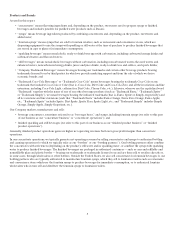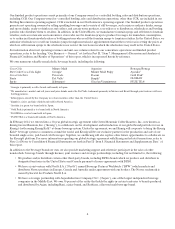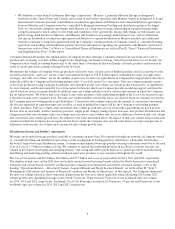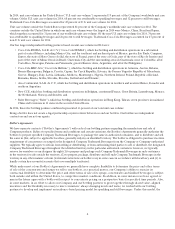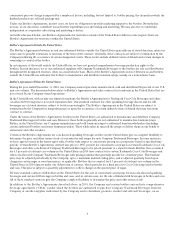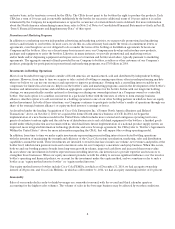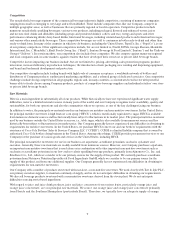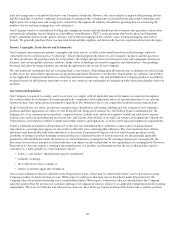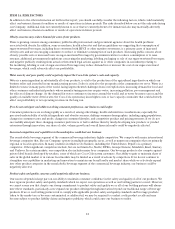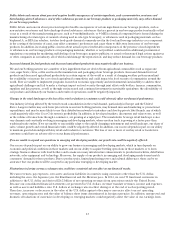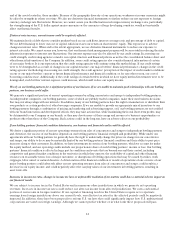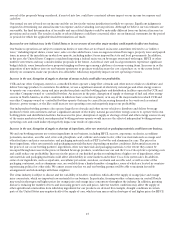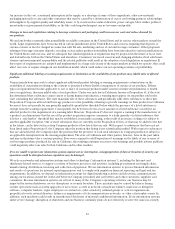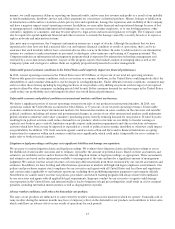Coca Cola 2014 Annual Report Download - page 15
Download and view the complete annual report
Please find page 15 of the 2014 Coca Cola annual report below. You can navigate through the pages in the report by either clicking on the pages listed below, or by using the keyword search tool below to find specific information within the annual report.13
Public debate and concern about perceived negative health consequences of certain ingredients, such as non-nutritive sweeteners and
biotechnology-derived substances, and of other substances present in our beverage products or packaging materials, may reduce demand
for our beverage products.
Public debate and concern about perceived negative health consequences of certain ingredients in our beverage products, such as
non-nutritive sweeteners and biotechnology-derived substances; substances that are present in our beverage products naturally or that
occur as a result of the manufacturing process, such as 4-methylimidazole, or 4-MEI (a chemical compound that is formed during the
manufacturing of certain types of caramel coloring used in cola-type beverages); or substances used in packaging materials, such as
bisphenol A, or BPA (an odorless, tasteless food-grade chemical commonly used in the food and beverage industries as a component
in the coating of the interior of cans), may affect consumers’ preferences and cause them to shift away from some of our beverage
products. In addition, increasing public concern about actual or perceived health consequences of the presence of such ingredients
or substances in our beverage products or in packaging materials, whether or not justified, could result in additional governmental
regulations concerning the marketing and labeling of our beverages, negative publicity, or actual or threatened legal actions against us
or other companies in our industry, all of which could damage the reputation of, and may reduce demand for, our beverage products.
Increased demand for food products and decreased agricultural productivity may negatively affect our business.
We and our bottling partners use a number of key ingredients that are derived from agricultural commodities such as sugarcane,
corn, sugar beets, citrus, coffee and tea in the manufacture and packaging of our beverage products. Increased demand for food
products and decreased agricultural productivity in certain regions of the world as a result of changing weather patterns may limit
the availability or increase the cost of such agricultural commodities and could impact the food security of communities around the
world. If we are unable to implement programs focused on economic opportunity and environmental sustainability to address these
agricultural challenges and fail to make a strategic impact on food security through joint efforts with bottlers, farmers, communities,
suppliers and key partners, as well as through our increased and continued investment in sustainable agriculture, the affordability of
our products and ultimately our business and results of operations could be negatively impacted.
Changes in the retail landscape or the loss of key retail or foodservice customers could adversely affect our financial performance.
Our industry is being affected by the trend toward consolidation in the retail channel, particularly in Europe and the United
States. Larger retailers may seek lower prices from us and our bottling partners, may demand increased marketing or promotional
expenditures, and may be more likely to use their distribution networks to introduce and develop private label brands, any of which
could negatively affect the Coca-Cola system’s profitability. In addition, in developed markets, discounters and value stores, as well
as the volume of transactions through e-commerce, are growing at a rapid pace. The nonalcoholic beverage retail landscape is also
very dynamic and constantly evolving in emerging and developing markets, where modern trade is growing at a faster pace than
traditional trade outlets. If we are unable to successfully adapt to the rapidly changing environment and retail landscape, our share of
sales, volume growth and overall financial results could be negatively affected. In addition, our success depends in part on our ability
to maintain good relationships with key retail and foodservice customers. The loss of one or more of our key retail or foodservice
customers could have an adverse effect on our financial performance.
If we are unable to expand our operations in emerging and developing markets, our growth rate could be negatively affected.
Our success depends in part on our ability to grow our business in emerging and developing markets, which in turn depends on
economic and political conditions in those markets and on our ability to acquire bottling operations in those markets or to form
strategic business alliances with local bottlers and to make necessary infrastructure enhancements to production facilities, distribution
networks, sales equipment and technology. Moreover, the supply of our products in emerging and developing markets must match
consumers’ demand for those products. Due to product price, limited purchasing power and cultural differences, there can be no
assurance that our products will be accepted in any particular emerging or developing market.
Fluctuations in foreign currency exchange rates could have a material adverse effect on our financial results.
We earn revenues, pay expenses, own assets and incur liabilities in countries using currencies other than the U.S. dollar,
including the euro, the Japanese yen, the Brazilian real and the Mexican peso. In 2014, we used 70 functional currencies in
addition to the U.S. dollar and derived $26.2 billion of net operating revenues from operations outside the United States.
Because our consolidated financial statements are presented in U.S. dollars, we must translate revenues, income and expenses,
as well as assets and liabilities, into U.S. dollars at exchange rates in effect during or at the end of each reporting period.
Therefore, increases or decreases in the value of the U.S. dollar against other major currencies affect our net operating
revenues, operating income and the value of balance sheet items denominated in foreign currencies. In addition, unexpected and
dramatic devaluations of currencies in developing or emerging markets could negatively affect the value of our earnings from,


